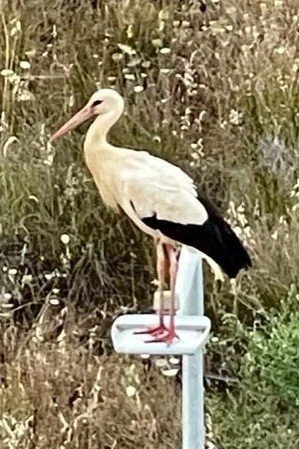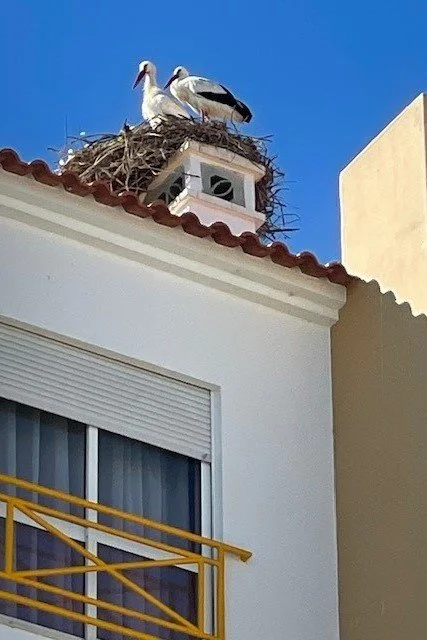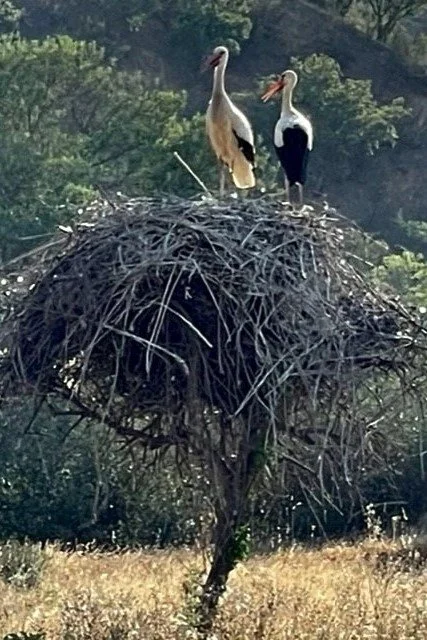Wondrous White Storks
Storks in a finely crafted chimney nest
Since arriving in Lagos, Portugal in November 2021, we’ve had the pleasure of seeing a significant number of white storks. In the Portuguese language they are called Cegonha branca. Our perception is that they are everywhere and it has become a favorite pastime with morning coffee, or an afternoon walk, to simply observe these amazing birds.
This white stork looks a little dusty after a windstorm brought sand to Lagos from Africa
Wherever we travel in the Algarve, and en route to Lisbon, we see remarkably constructed stork nests, oftentimes perched in trees, on posts, or covering old red brick chimneys. According to The Portugal News, a national 2014 census carried out on the species documented 11,694 storks’ nests.
The local storks typically nest in the Algarve, then fly South for the Winter months, although this trend seems to have shifted towards many storks remaining in the Algarve year-round. When the storks return, it’s usually to the same nest each year, where they meticulously perform ongoing repairs to maintain their homes in the best possible manner.
A stork palm tree neighborhood
The Portugal News also reported that, according to the Institute for Nature Conservation and Forests (ICNF), the white stork is described as being “strongly-rooted in Portuguese culture” and “a characteristic element of the landscape in many regions of the country, and a species normally admired and respected by the vast majority of the population.” The ICNF is responsible for managing the welfare of the storks and their nests, which are protected by law. We’ve been told by local residents that not only is disturbing, removing or destroying a stork nest without permission illegal, doing so is also considered to bring significant amounts of bad luck to the perpetrator(s).
Terri, our beloved friend and Lagos neighbor, also diligently oversees the welfare of the storks! She has named all of the stork couples within our line of sight and has become quite the expert on these captivating creatures, who pair for life. We keep an eye on Rhett and Scarlett when we are in town. Terri pays particular attention to Captain and Tennille, who expanded their family (as did all of the neighborhood storks) with cute little chicks this Spring.
Rhett and Scarlett resting and nesting
Mating season generally occurs during the month of April and continues into early May, resulting in three to five eggs per couple. Once the chicks hatch, one of the parents is always in the nest while the other hunts for small mammals, insects, fish, frogs, and even smaller birds to feed the family. The chicks live with their parents for about three months before gaining their independence.
According to National Geographic, “… storks are associated with good luck and rebirth—hence the fairy tale of white storks delivering new-born babies in slings from their beaks.” The same National Geographic article references a White Stork Project, taking place in the UK, with the goal of bringing the cherished white storks back to the British countryside after an absence of over 600 years.
We stopped to visit these storks during a drive between Lagos and Monchique
We understand why UK residents might miss these lovely birds. Their fascinating activities bring joy, entertainment and tradition to communities. Even their occasional bill-clattering is intriguing, which is created by clapping their beaks together in a rapid-fire manner while their heads bend backwards and their throats amplify the sound. We’ve heard this clattering when the storks excitedly great one another, which we find particularly charming.
Thank you for sharing these experiences with us …
- Stephen & Brenda






